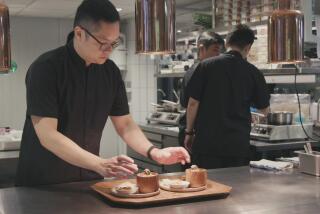Many Westerners Put Off by Betel Leaf Habit : In India, Almost Everyone Likes to Have a Good Chew
- Share via
NEW DELHI — Marco Polo observed it 700 years ago. Genteel Englishwomen were said to have fainted at the sight of it. Today, it is a $500 million-a-year business in India.
It is the ancient custom of chewing paan , or betel pepper leaf. It is the most visible Indian habit; millions across the country relentlessly chew the conical-shaped leaf and spit out its reddish residue.
The paan leaf is wrapped around betel nut, quicklime and a score of other flavorings geared to individual tastes. Some are mildly narcotic.
The practice gives many Indian taxi drivers bright red grins, leaves unsightly splotches on streets, sidewalks and other public places, and sometimes upsets tourists when the stream of betel juice comes too close.
From the humblest hut to palaces of former maharajahs, paan is part of Indian life. Elegant hostesses serve coffee and cigars after dinner, but reserve paan for the finale.
“No Indian meal is complete without a paan . It would be like having dinner in Paris without wine,” said B. K. Jha, a 66-year-old journalist and paan connoisseur who has been chewing if for 50 years.
“ Paan has become an essential accessory to the Indian life, associated with leisure, valor, cuisine and ritual.”
Indeed, betel leaf is among the few things that seem to bind rather than divide India, where adherents of the seven recognized religions and speakers of the 16 official languages are often at odds.
For addicts, paan can be an all-day habit, but it is normally taken after meals.
In an Indian home after a rich meal, a guest is offered his or her choice of sada (plain), mitha (sweet) and tamaku, which has a narcotic stimulant.
Flavorings include camphor, cardamom, clove, coconut, cinnamon, saffron, nutmeg, almond, melon seeds and aniseed. About 12 different types of stimulants or tobaccos can be added.
A first-class paan can have a vark, a layer of beaten silver or gold on the leaf that adds a touch of beauty and is chewed with the other contents.
Custom demands that you pop the full paan into your mouth and spit the first juice out. Depending on the quality, it takes from two minutes to half an hour to finish one leaf.
In homes, cuspidors are provided for guests, but since by custom the cuspidor is ornamental, the first reddish gush is exuded on the road outside.
Om Prakash Lalwani runs India’s best-known paan shop, the Prince Paan Bhandar in Old Delhi. He took over from his father, who opened the shop as a refugee from Pakistan in 1949. The shop now sells paan to more than 5,000 people a day and has a staff of 50 who travel across India to set up special stalls at marriages, birth ceremonies and funerals.
Paan is priced according to the contents and which of the 35 varieties of leaf is used. The most famous leaf is the benarsi, named for the Hindu holy city of Benares and said to be kept buried for months to eliminate any raw taste.
The cheapest paan at Lalwani’s shop sells for 14 cents and the deluxe beaten-gold variety for $1.75.
Lalwani says he can wrap a paan to last up to 48 hours and has customers who take them as gifts to friends in Europe and the United States.
In a more ordinary shop, paan can cost as little as 30 paise (2 cents).
Altogether, paan cultivation, marketing and sales provide employment to 5 million Indians.
Now, too, there is packaged paan , which comes in foil envelopes and is advertised in newspapers and magazines in much the same way as cigarette ads elsewhere. The government issues warnings--though not on the package--that paan can cause mouth cancer.
It doesn’t seem to stop Indians, however.
Even some foreign visitors try it, a far cry from the days when British gentlewomen were said to have fainted at the first sight of a paan chewer, mistaking the red spittle for blood.
It is not clear how and when paan came to India. Some say it was brought in spice-laden boats from Southeast Asia in AD 300.

